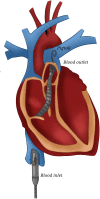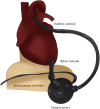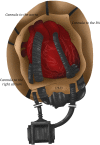Current and future options for adult biventricular assistance: a review of literature
- PMID: 38028456
- PMCID: PMC10657899
- DOI: 10.3389/fcvm.2023.1234516
Current and future options for adult biventricular assistance: a review of literature
Abstract
In cardiogenic shock various short-term mechanical assistances may be employed, including an Extra Corporeal Membrane Oxygenator and other non-dischargeable devices. Once hemodynamic stabilization is achieved and the patient evolves towards a persisting biventricular dysfunction or an underlying long-standing end-stage disease is present, aside from Orthotopic Heart Transplantation, a limited number of long-term therapeutic options may be offered. So far, only the Syncardia Total Artificial Heart and the Berlin Heart EXCOR (which is not approved for adult use in the United States unlike in Europe) are available for extensive implantation. In addition to this, the strategy providing two continuous-flow Left Ventricular Assist Devices is still off-label despite its widespread use. Nevertheless, every solution ensures at best a 70% survival rate (reflecting both the severity of the condition and the limits of mechanical support) with patients suffering from heavy complications and a poor quality of life. The aim of the present paper is to summarize the features, implantation techniques, and results of current devices used for adult Biventricular Mechanical Circulatory Support, as well as a glance to future options.
Keywords: biventricular assistance; end-stage heart failure; left ventricular assist device; orthotopic heart transplantation; total artificial heart.
© 2023 Loardi, Zanobini, Ricciardi and Vermes.
Conflict of interest statement
The authors declare that the research was conducted in the absence of any commercial or financial relationships that could be construed as a potential conflict of interest. The handling editor CD declared a past co-authorship with the author EV.
Figures









References
-
- Lund LH, Edwards LB, Kucheryavaya AY, Benden C, Christie J, Dipchand A, et al. The registry of the international society for heart and lung transplantation: thirty-first official adult heart transplant report – 2014; focus theme: retransplantation. J Heart Lung Transplant. (2014) 33:996–1008. 10.1016/j.healun.2014.08.003 - DOI - PubMed
-
- Cleveland J, Naftel D, Reece B, Murray M, Antaki J, Pagani FD, et al. Survival after biventricular assist device implantation: an analysis of the interagency registry for mechanically assisted circulatory support database. J Heart Lung Transplant. (2011) 30:862–9. 10.1016/j.healun.2011.04.004 - DOI - PubMed
Publication types
LinkOut - more resources
Full Text Sources

